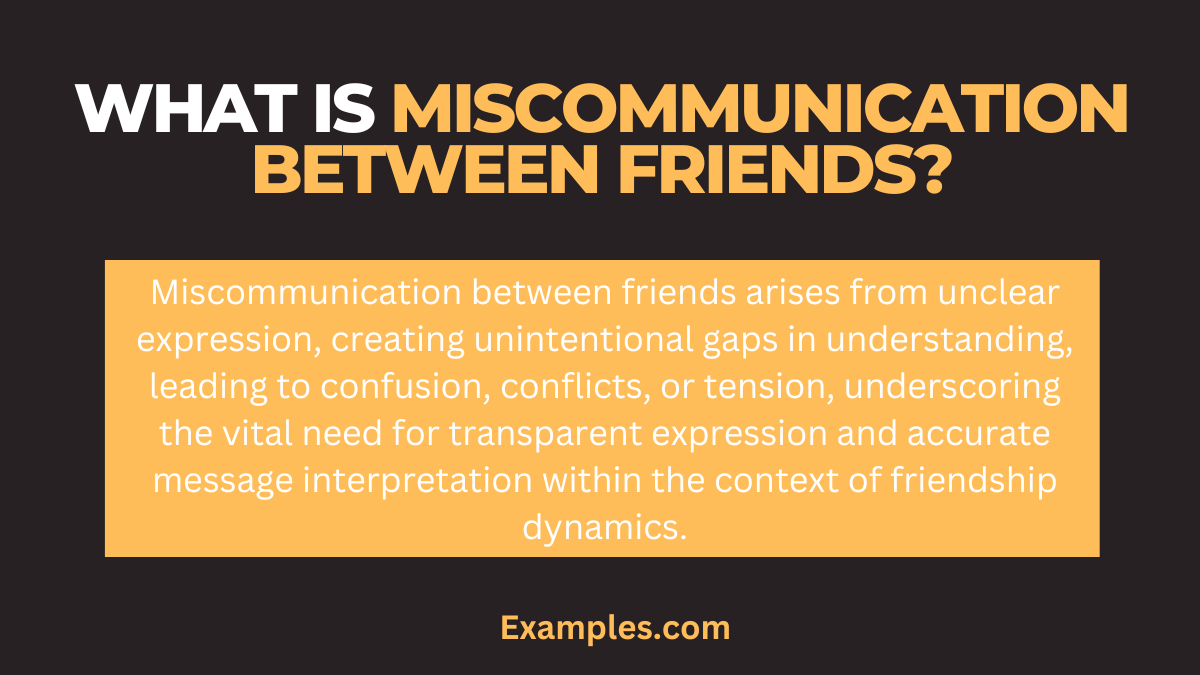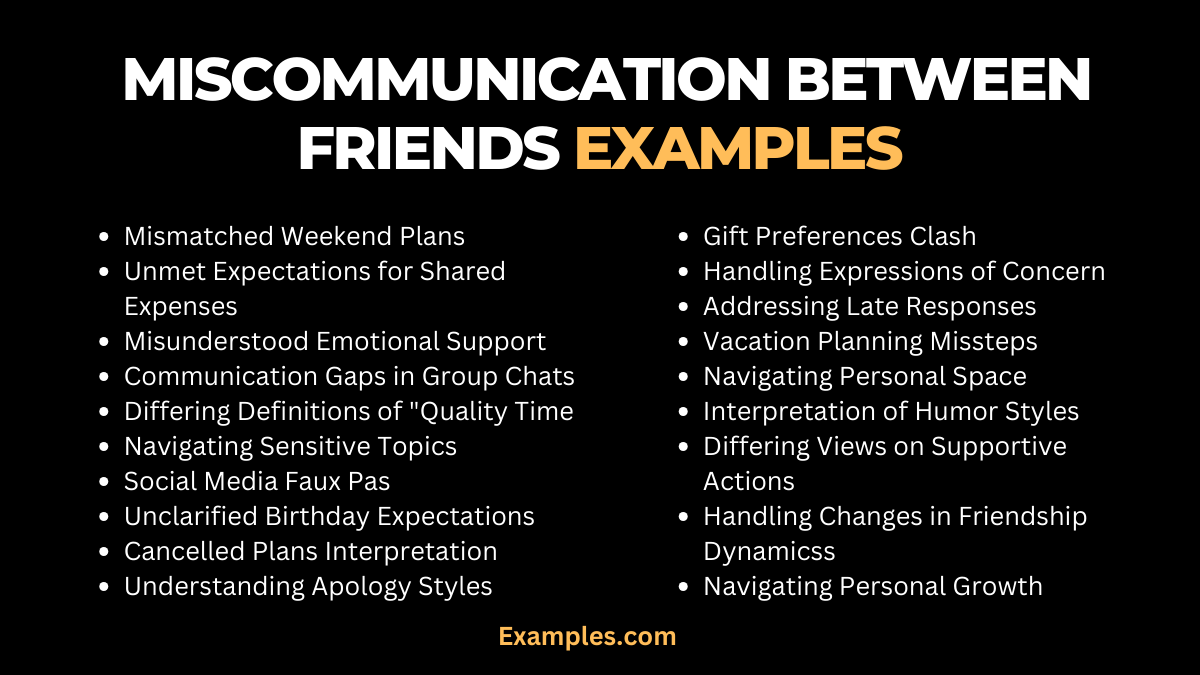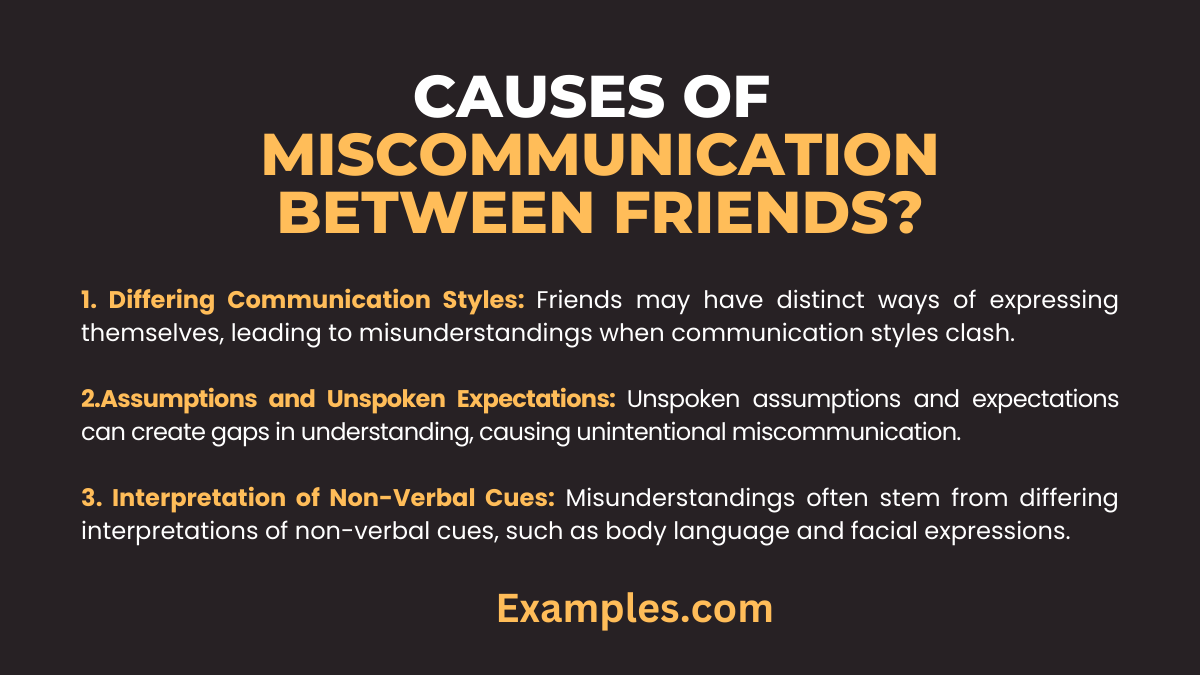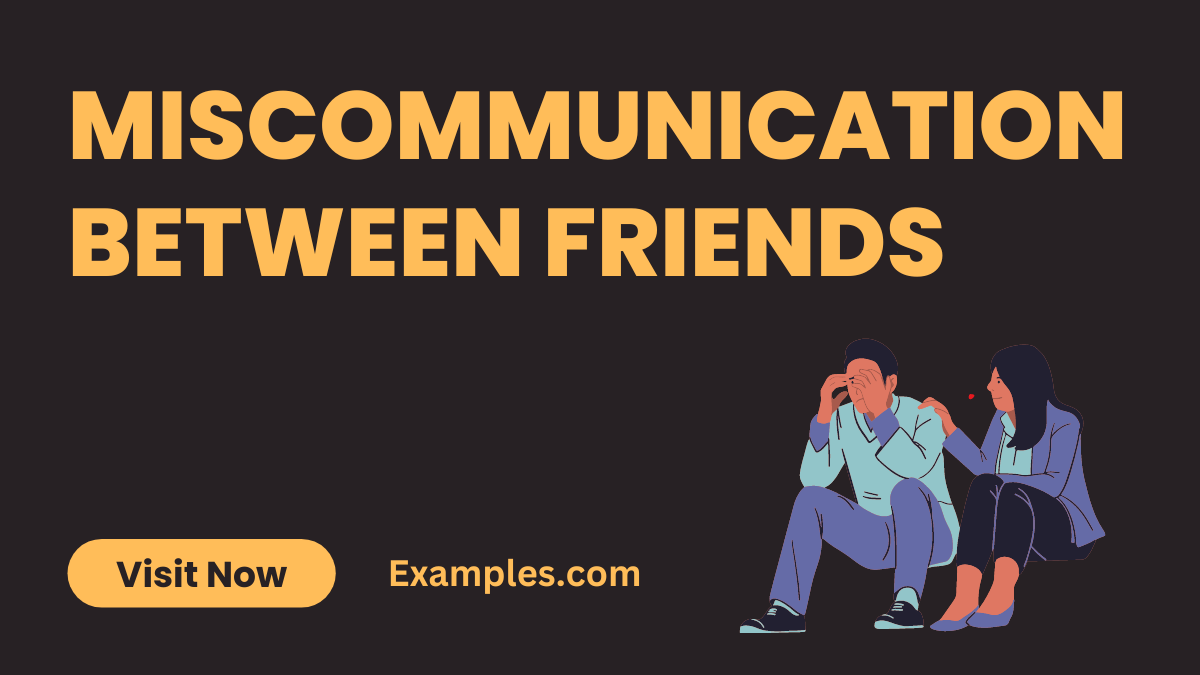19+ Miscommunication Between Friends Examples
Embark on a comprehensive exploration of “Miscommunication Between Friends: A Complete Guide with Communication Examples.” This guide delves into real-life scenarios to unravel the complexities of friend communication. Discover valuable insights, practical tips, and effective strategies to navigate and enhance your friendships by fostering clearer communication and understanding. Learn from diverse examples that illuminate the common pitfalls and dynamics within friend relationships, ensuring you can strengthen your bonds and overcome communication hurdles effortlessly.
What is Miscommunication Between Friends?

Miscommunication between friends occurs when there is a failure to express thoughts, feelings, or intentions clearly, leading to misunderstandings. In simple terms, it’s the unintentional gaps in understanding among friends that result in confusion, conflicts, or tension. This breakdown in effective communication highlights the importance of expressing oneself transparently and interpreting messages accurately within the context of friendship dynamics.
What is the Best Example of Miscommunication Between Friends?

In this scenario, a friend plans a surprise gathering, assuming the element of surprise would add joy. However, the invite had unclear details, and some friends missed the event, leading to disappointment. The well-intentioned surprise clashed with expectations, highlighting how miscommunication about event details can impact friendships. This example underscores the importance of clear communication, ensuring everyone is on the same page to avoid unintentional lapses in friendship dynamics.
20 Miscommunication Between Friends Examples

Explore the nuances of friend communication with this curated collection of examples. Each scenario sheds light on common pitfalls, offering valuable insights into miscommunication between friends and ways to navigate these challenges for stronger friendships.
- Mismatched Weekend Plans: Miscommunication arises when friends interpret “casual hangout” differently, clarifying plans ensures everyone is on the same page.
- Unmet Expectations for Shared Expenses: Confusion arises when friends have differing views on shared expenses; discussing financial expectations beforehand prevents misunderstandings.
- Misunderstood Emotional Support: Friends misinterpret the need for space as neglect; clear communication about emotional needs fosters supportive friendships.
- Communication Gaps in Group Chats: Miscommunication occurs in group chats when messages are unclear; using direct language ensures everyone comprehends the intended message.
- Differing Definitions of “Quality Time”: Conflict arises when friends have different expectations of quality time; discussing preferences ensures mutually enjoyable interactions.
- Navigating Sensitive Topics: Miscommunication arises when addressing sensitive topics; using empathy and open communication prevents unintentional conflicts.
- Social Media Faux Pas: Confusion occurs when friends misinterpret social media posts; expressing intentions clearly prevents unnecessary misunderstandings.
- Unclarified Birthday Expectations: Friends feel disappointed due to unmet birthday expectations; discussing preferences ensures celebrations align with individual desires.
- Cancelled Plans Interpretation: Miscommunication arises when friends cancel plans; clarifying reasons and rescheduling prevents potential hurt feelings.
- Mismatched Communication Frequency: Conflicts arise when friends have different expectations for communication frequency; discussing preferences fosters understanding.
- Gift Preferences Clash: Miscommunication occurs when friends have differing views on gift-giving; openly discussing preferences ensures thoughtful exchanges.
- Handling Expressions of Concern: Friends misinterpret concern as interference; clear communication about boundaries ensures respectful support.
- Addressing Late Responses: Miscommunication arises when friends perceive late responses differently; expressing expectations for response time fosters understanding.
- Navigating Personal Space: Conflict arises when friends have different views on personal space; establishing boundaries and discussing comfort levels is essential.
- Interpretation of Humor Styles: Miscommunication occurs when friends misinterpret humor styles; acknowledging diverse comedic preferences prevents unintended offense.
- Differing Views on Supportive Actions: Friends may interpret supportive actions differently; discussing expectations ensures gestures align with individual preferences.
- Handling Changes in Friendship Dynamics: Miscommunication arises when friends navigate evolving dynamics; openly addressing changes prevents assumptions and potential conflicts.
- Celebration Preferences Discrepancy: Friends feel misunderstood due to differing celebration preferences; discussing expectations ensures meaningful and enjoyable festivities.
- Navigating Personal Growth: Miscommunication occurs when friends embark on personal growth journeys; openly discussing changes fosters understanding and support.
- Understanding Apology Styles: Conflict arises when friends have different apology expectations; communicating apology styles prevents prolonged misunderstandings.
Explore these examples to enhance your awareness of friend miscommunication, fostering stronger and more resilient friendships.
Miscommunication Between Friends in Business Examples
Explore the dynamics of friend communication in business settings with these real-life examples. Uncover the challenges and effective strategies to navigate miscommunication between friends while maintaining professional relationships.
- Project Misalignment: Miscommunication arises when friends misinterpret project goals; regular check-ins and clarifications ensure alignment for successful collaboration.
- Conflicting Leadership Styles: Friends experience tension due to differing leadership approaches; open communication about expectations fosters a harmonious work environment.
- Interpretation of Feedback: Miscommunication occurs when friends perceive feedback differently; encouraging transparent discussions ensures constructive critique is well-received.
- Navigating Work-Life Balance: Conflicts arise when friends have contrasting views on work-life balance; openly discussing expectations ensures a supportive and understanding workplace.
- Decision-Making Differences: Friends encounter challenges when decision-making styles clash; creating a process that accommodates diverse perspectives ensures collaborative choices.
Miscommunication Between Friends at School Examples
Delve into the realm of friend communication within educational settings, exploring how miscommunication impacts relationships. Gain insights into effective strategies to foster clearer communication and understanding.
- Group Project Misunderstandings: Miscommunication arises when friends have differing expectations for group projects; establishing clear roles and expectations ensures a successful collaboration.
- Exam Preparation Confusion: Friends experience tension due to miscommunication about study plans; openly discussing study habits and expectations enhances academic cooperation.
- Interpretation of Class Participation: Miscommunication occurs when friends interpret class participation differently; clarifying expectations fosters an inclusive and supportive learning environment.
- Handling Friendship in Academics: Conflicts arise when friends navigate friendship within academic contexts; openly addressing boundaries ensures a harmonious balance between friendship and academics.
- Communication Gaps in Extracurricular Activities: Friends encounter challenges in extracurricular activities due to communication gaps; establishing clear communication channels ensures smooth coordination and participation.
What are the causes of Miscommunication Between Friends?

Miscommunication between friends can strain relationships, leading to confusion and conflicts. Understanding the causes behind these breakdowns in communication is crucial for fostering healthier and more resilient friendships.
- Differing Communication Styles: Friends may have distinct ways of expressing themselves, leading to misunderstandings when communication styles clash.
- Assumptions and Unspoken Expectations: Unspoken assumptions and expectations can create gaps in understanding, causing unintentional miscommunication.
- Interpretation of Non-Verbal Cues: Misunderstandings often stem from differing interpretations of non-verbal cues, such as body language and facial expressions.
- Inadequate Expression of Feelings: Friends may struggle to articulate their feelings effectively, leading to confusion about emotions and intentions.
- Social Media and Digital Misinterpretations: The digital realm can introduce miscommunication, as friends may misinterpret messages or tones conveyed through social media.
- Lack of Active Listening: Failure to actively listen to each other can result in miscommunication, as key details may be overlooked or misunderstood.
- Mismatched Expectations: Differences in expectations regarding time, effort, and commitment to the friendship can contribute to miscommunication.
- Fear of Confrontation: Friends may avoid addressing concerns directly, fearing confrontation, which can lead to unresolved issues and miscommunication.
- Cultural and Background Variances: Diverse cultural backgrounds may lead to varying communication norms, causing miscommunication between friends from different cultural contexts.
- Changes in Relationship Dynamics: As friendships evolve, changes in dynamics can introduce miscommunication, particularly when expectations haven’t been openly discussed.
Understanding these causes empowers friends to proactively address potential pitfalls and nurture clearer communication, fortifying their bonds against the challenges of miscommunication.
What do you do to resolve miscommunication Between Friends?
Miscommunication between friends can strain relationships, but understanding how to resolve conflicts is key to fostering stronger bonds. Follow these steps to navigate and address miscommunication effectively:
Introduction: Friendship miscommunication is inevitable, but proactive resolution strengthens connections. By acknowledging differences and actively seeking resolution, friends can enhance understanding and fortify their relationships.
- Active Listening:
- Encourage friends to listen attentively to each other’s perspectives.
- Validate feelings and demonstrate empathy to foster mutual understanding.
- Expressing Feelings Clearly:
- Encourage open and honest expression of feelings.
- Use “I” statements to avoid sounding accusatory and promote personal responsibility.
- Avoiding Assumptions:
- Discourage friends from making assumptions about each other’s intentions.
- Encourage seeking clarification instead of jumping to conclusions.
- Choosing the Right Time and Place:
- Suggest resolving issues in a calm and private setting.
- Timing is crucial; address miscommunication when both friends are receptive.
- Using Clear and Direct Language:
- Emphasize the importance of clear and direct communication.
- Encourage friends to articulate their thoughts without ambiguity.
- Understanding Different Communication Styles:
- Highlight the diversity in communication styles among friends.
- Promote acceptance of these differences to avoid misinterpretations.
- Apologizing and Forgiving:
- Encourage a culture of apology and forgiveness.
- Acknowledge mistakes, apologize sincerely, and be open to forgiving.
- Seeking Mediation if Necessary:
- If miscommunication persists, suggest seeking mediation.
- A neutral third party can offer insights and facilitate constructive dialogue.
Tips for Effective Miscommunication Between Friends?
Navigating potential miscommunication in friendships requires a thoughtful approach. Here’s a guide to foster effective communication and strengthen your bonds with friends:
1. Active Listening:
- Practice attentive listening to understand your friends’ perspectives.
- Validate their feelings and express empathy during conversations.
2. Clear Expression of Expectations:
- Clearly communicate your expectations and boundaries to avoid misunderstandings.
- Encourage friends to share their expectations openly.
3. Open and Honest Communication:
- Foster an environment where honesty is valued and encouraged.
- Address concerns promptly to prevent unresolved issues.
4. Clarify Misunderstandings Promptly:
- When miscommunication occurs, address it promptly and openly.
- Seek clarification rather than making assumptions.
5. Use “I” Statements:
- Express feelings using “I” statements to avoid sounding accusatory.
- Encourage friends to communicate their needs similarly.
6. Be Mindful of Non-Verbal Cues:
- Pay attention to non-verbal cues like body language and facial expressions.
- Interpret and respond to non-verbal signals effectively.
7. Understand Different Communication Styles:
- Recognize that friends may have different communication styles.
- Adapt your approach to align with their preferred style.
8. Choose Appropriate Communication Channels:
- Consider the context and use appropriate communication channels.
- Some discussions may be better suited for face-to-face conversations.
By incorporating these tips into your friendships, you can create a communication-rich environment, minimizing the chances of miscommunication and strengthening the bonds you share with your friends.
In conclusion, this guide unveils the intricacies of miscommunication between friends, offering valuable insights through real-life examples. Navigating misunderstandings with effective communication strategies is key to fostering stronger and more resilient friendships. By understanding the common pitfalls and employing practical tips, friends can build lasting connections, ensuring their relationships thrive in the face of communication challenges.



